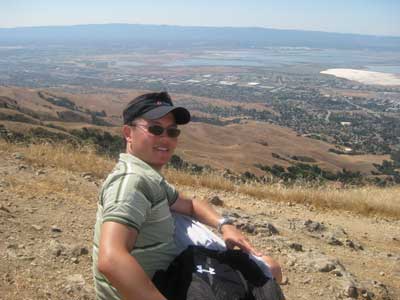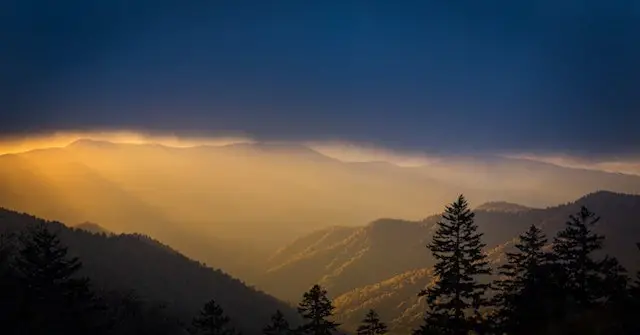
Sitting at a whopping 6,643 feet above sea level, Clingmans Dome is the highest point in all of Tennessee. It’s also the third highest peak east of the Mississippi River, giving it a relatively high status in the hiking community.
A trip to Clingmans Dome is honestly a once in a lifetime experience. If you’re planning to visit this beautiful destination, there are plenty of locations and activities for you to visit and take part in here.
Take a drive through the Smokies
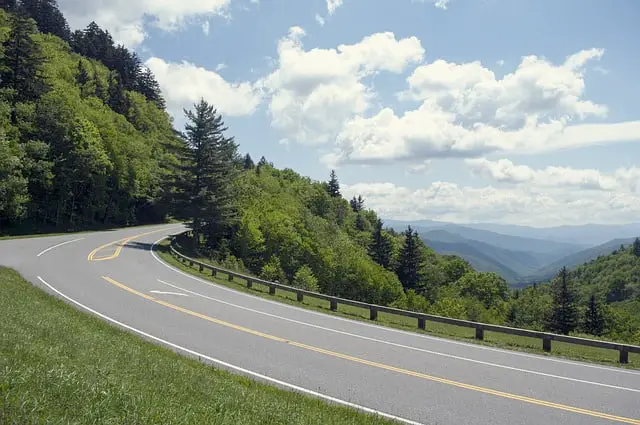
Whether you come from the North Carolina or Tennessee side of the Great Smoky Mountains, you will have to travel on the Newfound Gap Road (US 441) to hit Clingmans Dome. This 33 mile drive across Great Smoky National Park is an incredible experience, as it covers almost everything the park has to offer.
Each spot along this road is pretty close to the main road, allowing you to explore each of them without devoting too much time to any one attraction in particular. A straight through drive takes less than an hour, but stopping at every suggested point will increase that duration by several hours. This is especially during the busy months, when many vacationers are making the same drive you are.
If you want to avoid the traffic, I recommend visiting the Smokies in fall. One of the great things about the Smoky Mountains is that they are equally stunning in all seasons. The bright orange of fall, the white of winter, or the green of summer and spring all make the Smoky Mountains look absolutely phenomenal.
Visit the Sugarlands Visitor Center
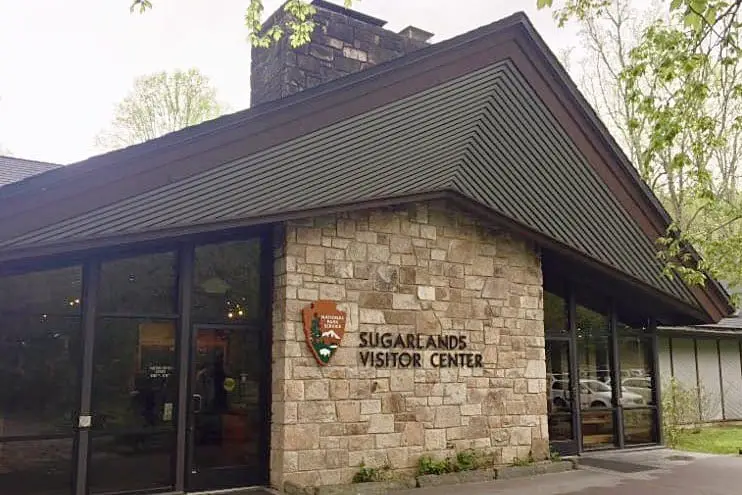
Located 2 miles from Gatlinburg and 8.8 miles from Clingmans Dome, the Sugarlands Visitor Center is the starting point of your journey along the Newfound Gap Road.
Equipped with all of the necessary basics you’d expect from a visitor center, the Sugarlands Visitor Center has multiple exhibits on the natural history of the Clingmans Dome area. It also has a 20 minute film about the National Park ‒ arguably the best way to learn the most essential information about the surrounding region.
Visitors seeking additional information or souvenirs will find the information center, bookstore and gift shop to be welcome additions to the Sugarlands facility. You can also find restrooms, telephones and vending machines available to the public as well.
Out of the four Visitors Centers of the National Park, this is the first one that most people encounter. If you plan on exploring the area further, pick up a park map and ask a ranger some questions about the spots you plan on heading to.
Operating Hours
The Sugarlands Visitor Center remains open all year long, with the exception of Christmas. However, the timings change monthly. Here is an updated schedule of Visitor Center operational hours:
- January and February: 8:00 AM to 4:30 PM
- March: 8:00 AM to 5:00 PM
- April and May: 8:00 AM to 6:00 PM
- June, July and August: 8:00 AM to 7:00 PM
- September and October: 8:00 AM to 6:00 PM
- November: 8:00 AM to 5:00 PM
- December: 8:00 AM to 4:30 PM
Admire the Nature from Campbell Overlook
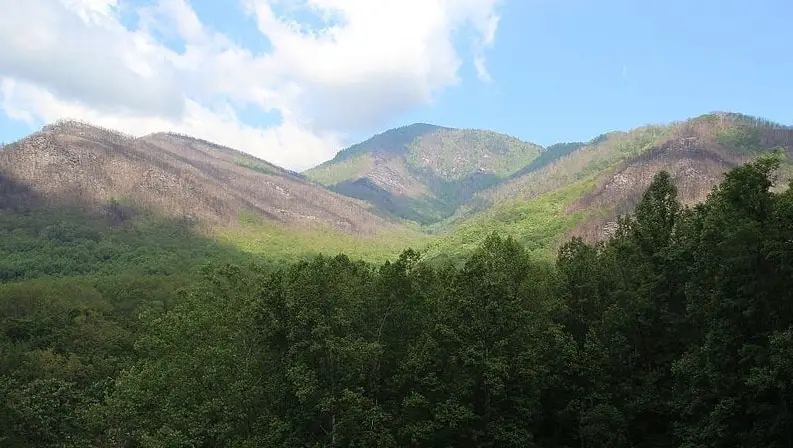
Located at about 2.5 miles south of the Sugarlands Visitor Area, the Campbell Overlook is the next place you should stop on your drive to Clingmans Dome. Offering an astounding and unbelievable view of the 6,593 foot high Mt. LeConte, sightseers and photographers alike will find this a must stop location.
Nearby the overlook, you will also find informational signs about the various trees that grow along the mountainside of Mt. LeConte. In total, 99 tree species are growing and thriving in the Great Smoky Mountains ‒ and many of them can be seen from this overlook. In particular, Mt. LaConte is covered with Pine Oak, Mixed Oak, Red Spruce-Fraser Fir, Health Bald, Cove Hardwood, Hemlock, and Northern Hardwood.
There are two parking lots near this overlook, so there should be plenty of space to park ‒ even in the busy season. If you want to have a closer look at the natural landscape, there is a quiet pathway that leads down into the forest surrounding the overlook.
A walk down the path will reveal the remains of old farmsteads as well as the old roadbed which links the Campbell Overlook to White Oak Flats (now called Gatlinburg).
A bit of history
Campbell Overlook is named after Carlos C. Campbell, the director of Knoxville Chamber of Commerce in the 1930s. He was instrumental in the promotion of the Great Smoky Mountains National Park’s establishment, and even wrote a book about his work for the National Park. It is called “Birth of a National Park” (Available at the Visitor Centers’ bookstores).
Plan a picnic at the Chimneys Picnic Area
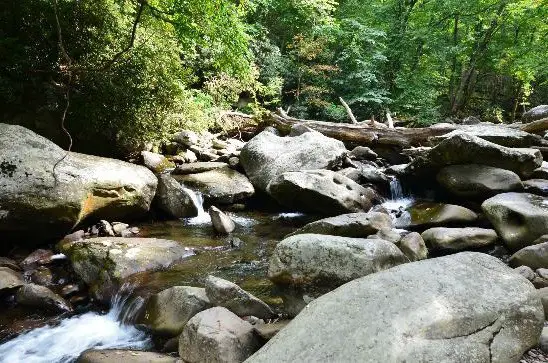
The next suggested stop on the Newfound Gap Road is the Chimneys Picnic Area. Located about 5.5 miles from Clingmans Dorm, this dedicated picnic area has 68 tables ‒ more than enough to accommodate even the highest amounts of tourist traffic. Each table stands on a level pad and has its own BBQ grill, allowing for more than just a picnic of prepackaged food.
The Chimney picnic area is not just known for picnicking though. A few of its tables sit alongside the Little Pigeon River, which is deep enough for fishing and swimming.
Although there are usually enough picnic tables for everyone, some spots are better than others. If you want to get one of the prime locations, try to arrive earlier or book beforehand.
The best thing about this spot is the simple parking rules. For the sake of sheer convenience, you’re allowed to park right at your table.
If you have a physical handicap, there are a few reserved tables situated right near the restrooms. However, most of the tables are honestly very close to the restrooms, so any table will work if you’re worried about that.
Operating hours
The Chimney Picnic Area is open from March 15th to November 30th from dawn until sunset ‒ or 8 PM ‒ whichever is earlier.
The open hours do change from time to time though. Because of this, it’s always smart to visit the National Park Service’s Great Smoky Mountains Picnicking website before traveling.
Drive through the historic Newfound Gap
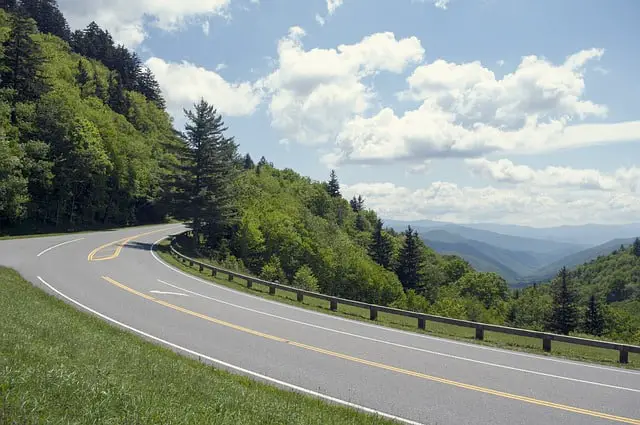
14.7 miles down the Newfound Gap Road lies the roadway’s namesake: the Newfound Gap.
With an elevation of 5,046 feet, the Newfound Gap is the lowest drivable pass in the Great Smoky National Park. When you reach this point, you’ll be about 5.3 miles away from Clingmans Dome.
The main attraction of this location is the consistently stunning view of the surrounding landscape it offers.
No matter what the season is, the Newfound Gap retains a refined beauty all year long. Spring brings wildflowers and dramatic hues, while summer brings a blanket of lush green. If you visit during the fall, the vibrant autumn colors will take your breath away. Similarly, the winter will give a completely different vibe with white snow-covered peaks and the remains of fallen leaves.
The Newfound Gap is also significantly cooler than the surrounding lowlands. When you get out of the car, don’t be surprised if the temperature changes drastically here. When it snows, it usually receives more than the surrounding area. An average of 70 inches of snow falls at the gap during a typical year, so make sure to keep a light jacket with you ‒ even if you’re travelling during the summer.
A bit of history
Before the discovery of the Newfound Gap in 1872, the road that traversed the Smokies crossed this area at Indian Gap, which is situated about 1.5 miles from the current site. A Swiss Geologist, Arnold Guyot, declared the Newfound Gap to be the lowest passage in the Smoky Mountains.
Mount Guyot, the second tallest peak in the Smoky Mountains, is named after Arnold. Using a standard barometer, he calculated the heights of mountains by measuring the changes in the air pressure. His work was almost always within 2% to 3% of the actual values.
Reach the summit of Clingmans Dome
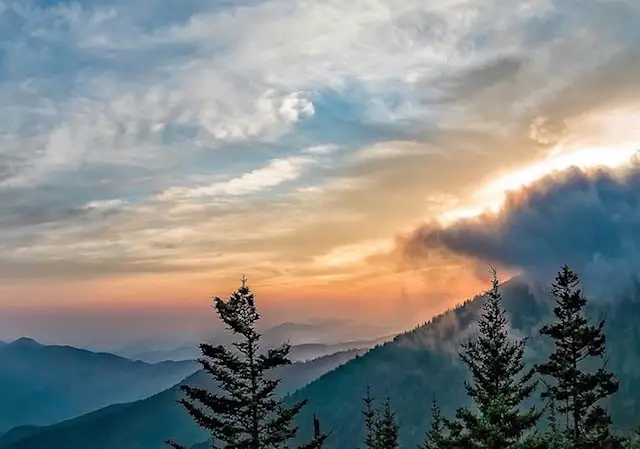
Contrary to popular belief, the ‘Dome’ on Clingmans Dome does not refer to the man made artificial observation tower ‒ it refers to the mountain top itself. And climbing to the top of this “Dome” is one of the best things to do in the Clingmans Dome area.
The road to the base of the mountain is pretty easy to follow ‒ take Clingmans Dome Road from US 441, and drive seven miles to reach the Clingmans Dome Visitor Center. This spot will also contain restrooms, a parking lot, and a trailhead to the summit.
While the trail to the top of the mountain is short and paved, it does have a pretty steep incline. This incline might be a challenge for people with strollers or wheelchairs, so take care if you have or are traveling with one of these wheeled devices.
Fortunately, there are many benches available along the way up, so you don’t have to make the whole climb in one go. Allow yourself to sit, breathe, and enjoy the scenic views from the benches before moving on.
Once you reach the summit, you’ll have a 360 degree aerial view of the magnificent Smoky Mountain range. Make sure to bring a camera, as there are a bunch of sights you’ll want to take a second look at later. On clear days, the view can stretch as far as 100 miles into the distance. However, if the weather is cloudy or raining, the view might be as short as 20 miles beyond the mountaintop.
Because you gain 332 feet of height, the temperature often changes drastically when compared to the climate at the base of the monuntain. The weather up at the top of the Dome can be 20 degrees colder ‒ and it is often a damp, frigid cold. I recommend bringing a heavy waterproof jacket to deal with the sudden weather changes.
You should also know that the trail to Clingmans Dome also links up with many of the other famous hiking trails in the Smokies. These include the Forney Creek Trail, the Appalachian Trail and the Forney Ridge Trail. Because the Clingmans Dome parking lot is small and often fills up quickly, you can use these alternate paths to make your way to the summit.
Go Camping at the Smokemont Campground
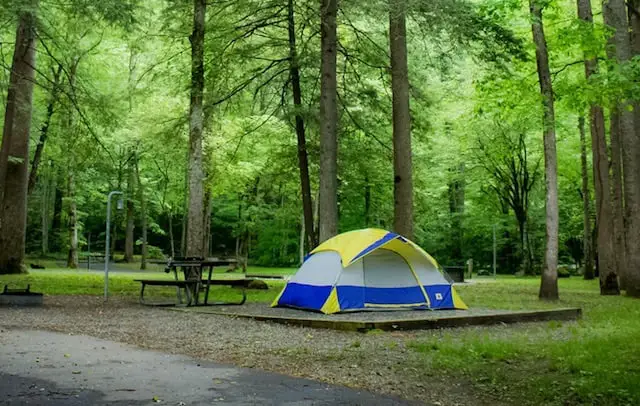
A wilderness trip to Clingmans Dome wouldn’t be complete without at least one solid night of camping. If you’re looking for an authentic camping experience in the Smoky Mountains, the Smokemont Campground is probably your best bet. Situated on the North Carolina side of the Newfound Gap road, the Smokemont Campground contains all of the camping amenities you might want:
- Flush toilets
- Drinking water
- Sinks for washing dishes
- BBQ grills
- Campfire rings
- Picnic tables
- An emergency phone
- A manned ranger station
- A food locker
- Sites for both tents and RVs
Camping at the Smokemont Campground also gives you quick access to some of the best hiking, fishing, wildlife viewing, biking, and horseback riding spots in the area.
Fishing is the most popular activity around the campground, as there are several streams nearby that have an abundance of trout. Hiking is another popular activity, as you can easily access the major trails from this campground.
Wildlife viewing is another fun activity to do in the Great Smoky Mountains National Park. Home to over 1,500 bears and a magnificent array of animal life, a night at the Smokemont Campground gives you a good chance of seeing an animal you’ve never encountered before.
Here’s some additional information visitors to the Smokemont Campground should know before attending:
- The campground is open all year round.
- The campground gets extremely popular in the peak season, so try to reserve a spot a few months in advance.
- There is a $25/night charge to camp here. If you’re looking for a budget camping opportunity, I advise looking elsewhere.
- There are electricity hookups for those who need them.
- Generators are NOT allowed. If you need to use a generator when you camp, please visit another campsite with a more lenient generator policy.
- The campsite does have a quiet area for those who don’t want to be exposed to the hubbub of a busy campsite. If you do get a spot in this quiet area, please be respectful of the rules and refrain from yelling, playing music, or making any other noises that might annoy your fellow campers.
Visit the Historic Mingus Mill

Mingus Mill is one of the major attractions of the Great Smoky Mountains National Park. If you have an interest in history, I highly recommend checking out the old Mingus Mill ‒ which is incredibly still operational today.
This article is owned by Recapture Nature and was first published on September 18, 2019
Historians believe the Mingus Family moved to the Clingmans Dome area in the late eighteenth century. According to them, the current Mingus Mill building is the second one to have been built on this site. The Mingus Family completed this rendition of the mill in 1886, and it quickly became an area attraction due to its use of advanced equipment. In particular, visitors were fascinated by the mill’s use of a steel turbine ‒ an extremely innovative piece of equipment for the late 1800s.
The designer of Mingus Mill was Sion Thomas Early, an apprentice millwright who lived in Virginia. According to preserved documents, the initial build cost about $600.00. When the National Park administration took over the area in 1968, they fully restored the Mingus Mill to keep the heritage alive.
The Mingus Mill was the biggest mill in the area and served more than 200 families. Some people would bring their wheat and corn to be grounded, while others would come to buy flour.
The mill is routinely open for visitors and has public restrooms. You can visit during the operating hours of 9:00 AM to 5:00 PM daily. However, the Mill is usually closed from mid-November to mid-March due to inclement weather in the region.
Visit at the Oconaluftee Visitor Center
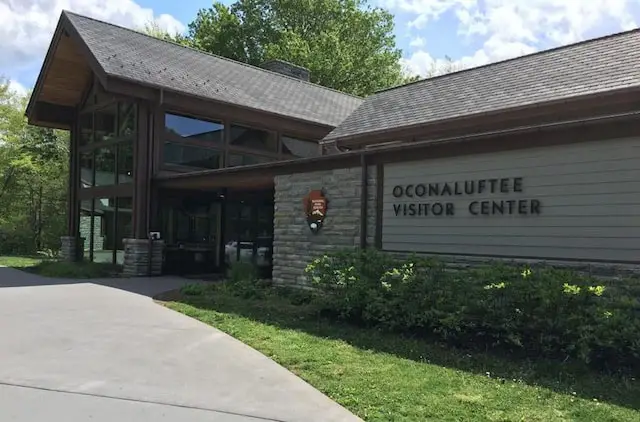
The Oconaluftee Visitors Center would be your last stop if you started driving on Newfound Gap Road from the Tennessee side of the Smokies.
The current Oconaluftee Center is actually the rebuilt version. The original Oconaluftee Visitor Center was built by the Civilian Conservation Corps (CCC) in the early 1900s. The current building opened in 2011 as the very first visitor center to be built since the 1960s.
Design fans will find visiting this location particularly enjoyable, as the building features innovative architecture with some really unique eco-friendly features. The geothermal heating and cooling system is probably the highlight of the building’s construction, although you’ll probably find the aesthetic aspects of the design just as interesting.
Architecture aside, the Visitor Center also has an amazing collection of exhibits depicting the rich culture and history of Oconaluftee valley.
The building isn’t the only reason to visit the Visitor Center. As you probably know, Smoky Mountains National Park has many exciting hiking trails. One of the most famous trails ‒ the Oconaluftee River Trail ‒ starts at this point. Another great trail ‒ the Mingus Creek trail ‒ is also nearby. This trail is particularly beautiful, as it offers easy access to the high backcountry of the Smoky Mountains.
The Visitor Center also contains a bookstore, a gift shop, and an information center inside the building.
This article is owned by Recapture Nature and was first published on September 18, 2019
A visit to this spot is also a must if you enjoy spotting rare wildlife. While you’re here, keep an eye on the fields surrounding the building. You might get lucky and spot an elk, as they are occasionally seen grazing around dusk and dawn. If you show up and no elk are present, you can ask one of the rangers to direct you to some other spots with a higher than normal likelihood of spotting an elk.
The Oconaluftee Visitor Center stays open year long, with the exception of Christmas day. The operating hours do vary from month to month though. If you do plan on visiting, check this schedule to ensure you make it in time:
- January and February: 8:00 AM to 4:30 PM
- March: 8:00 AM to 5:00 PM
- April and May: 8:00 AM to 6:00 PM
- June, July and August: 8:00 AM to 7:00 PM
- September and October: 8:00 AM to 6:00 PM
- November: 8:00 AM to 5:00 PM
- December: 8:00 AM to 4:30 PM
Go riding at the Sugarland Riding Stables
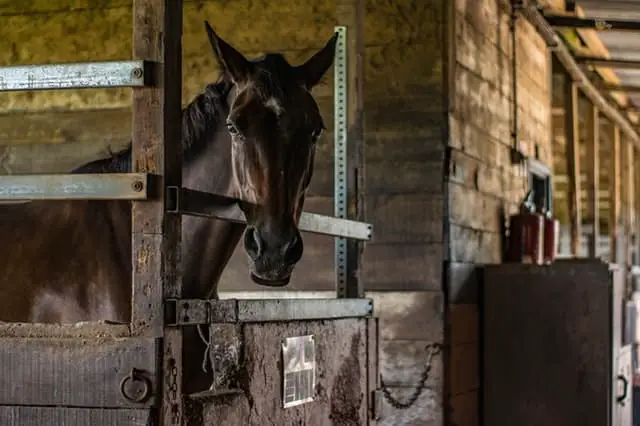
Avid horse riders and equine beginners will both find a visit to the Sugarland Riding stables a more than enjoyable experience. Situated in Gatlinburg ‒ just a short drive from Clingmans Dome ‒ the experts riders at Sugarland will provide you with horses, training, and access to some of the best riding trails in the state of Tennessee.
If you’d like to give horse riding at Sugarland a go, here’s some additional information you should be aware of:
- Sugarland has more than 40 horses ‒ all of which are trained for and experienced in mountain riding.
- Horse sizes range from 13 hands to 17 hands tall, so visitors of all sizes will find a horse that suits them.
- Because of the rocky and uneven terrain in Great Smoky Mountains National Park, all guided horseback tours are given at a walking pace. Riders looking to move at a faster pace will need to find a stable that doesn’t specialize in guided mountain tours.
- An hour of riding covers about four miles of wooded trails and costs $35 per person.
- 90 minutes of riding covers about six miles of wooded trails and costs $52.50 per person.
- Two hours of riding covers about eight miles of wooded trails and costs $70 per person.
- Four hours of riding covers about 15 miles of wooded trails and costs $140 per person.
- The two hour and four hour options are reserved for experienced riders only.
- To ensure the safety of horses and riders, Sugarland does not allow riders to bring backpacks, purses, cameras, food, or drink on their guided tours.
Visit Deep Creek National Park
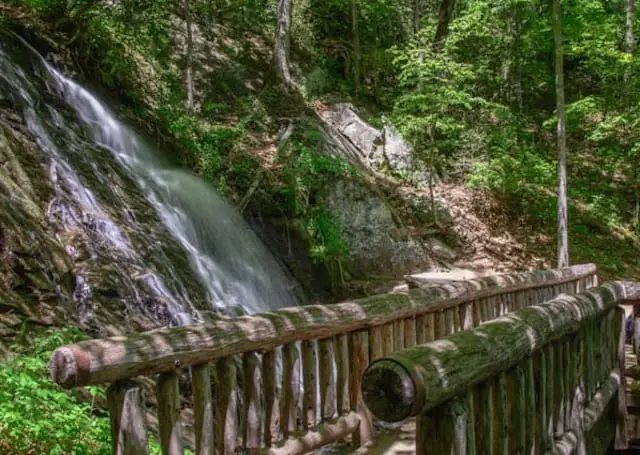
Deep Creek National Park is located in Bryson City, NC ‒ less than five miles from the peak of Clingmans Dome. This area is celebrated amongst hikers, cyclists, and campers alike.
Hiking
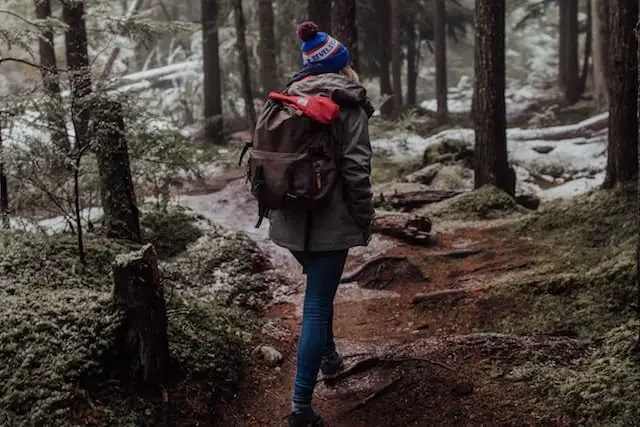
Deep Creek is home to numerous waterfalls, and hikers who visit the park are privy to some particularly gorgeous loop hikes that lead up to these scenic cascades.
If you go hiking in this park, I recommend taking one of the following trails:
- Juney Whank Falls (0.6 miles)
- Three Waterfalls Loop (2.4 miles)
- Deep Creek-Indian Creek Loop (4.4 miles)
Longer loop hikes are also available for hikers who are feeling particularly adventurous, but these won’t offer better views than the shorter hikes listed above.
The trails to the waterfall hikes start at the parking area, which is located at the end of Deep Creek Road ‒ also across the river from Deep Creek Campground.
Cycling
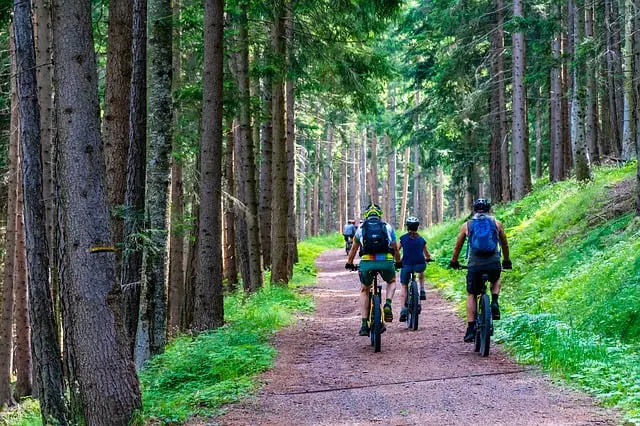
Cyclists are more limited than hikers are, as most trails prohibit mountain biking. However, there are two trails that cyclists are allowed on ‒ the Deep Creek and Indian Creek trails are both open to all kinds of bikes. These don’t lead directly to any of the waterfalls though, so sightseers will want to keep the bike in the car and take one of the walking trails instead.
This article is owned by Recapture Nature and was first published on September 18, 2019
Camping
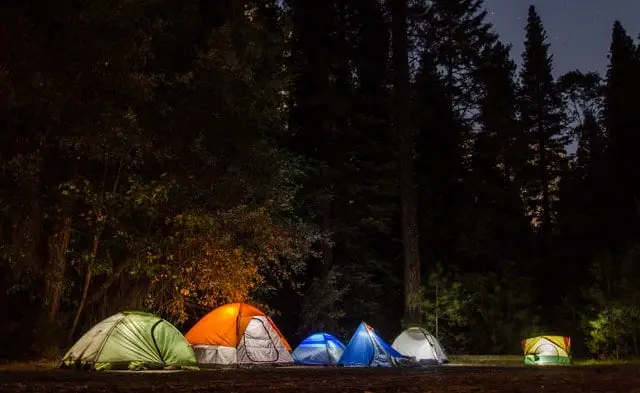
Camping in the Deep Creek Campground is allowed from early April all the way until the later parts of October. If you want to camp here, there are some things you should know:
- There are 55 campsites in total. These differ in size, and you can use different site sizes depending on how large your camping group is.
- The Campground has a large communal bathhouse, complete with individual rooms. And yes, they do have hot showers available.
- The Campground has 7 tent-only sites situated on the sides of Deep Creek itself.
- There are 10 sites with full power hookups available.
- There are 16 RV sites with full power hookups available.
- There are three sheltered campsites with access to electricity and water.
- Some campsites have cable TV access ‒ though I don’t recommend taking this, as it really ruins the whole camping experience.
- Prices range from $27 for a primitive tents-only site to a $50 creekside site with a 50 amp power hookup.
- There are also cabins available, ranging in price from a $79 cabin with 3 beds to a $195 cabin with 7 beds.
- Check-in time is 1 pm for campsites and 3 pm for cabin renters. You need to check out of both campsites and cabins by 11 am the next day.
- The camping season typically runs from early April to late October. If you want to camp outside of these dates, you’ll need to find another campground.

